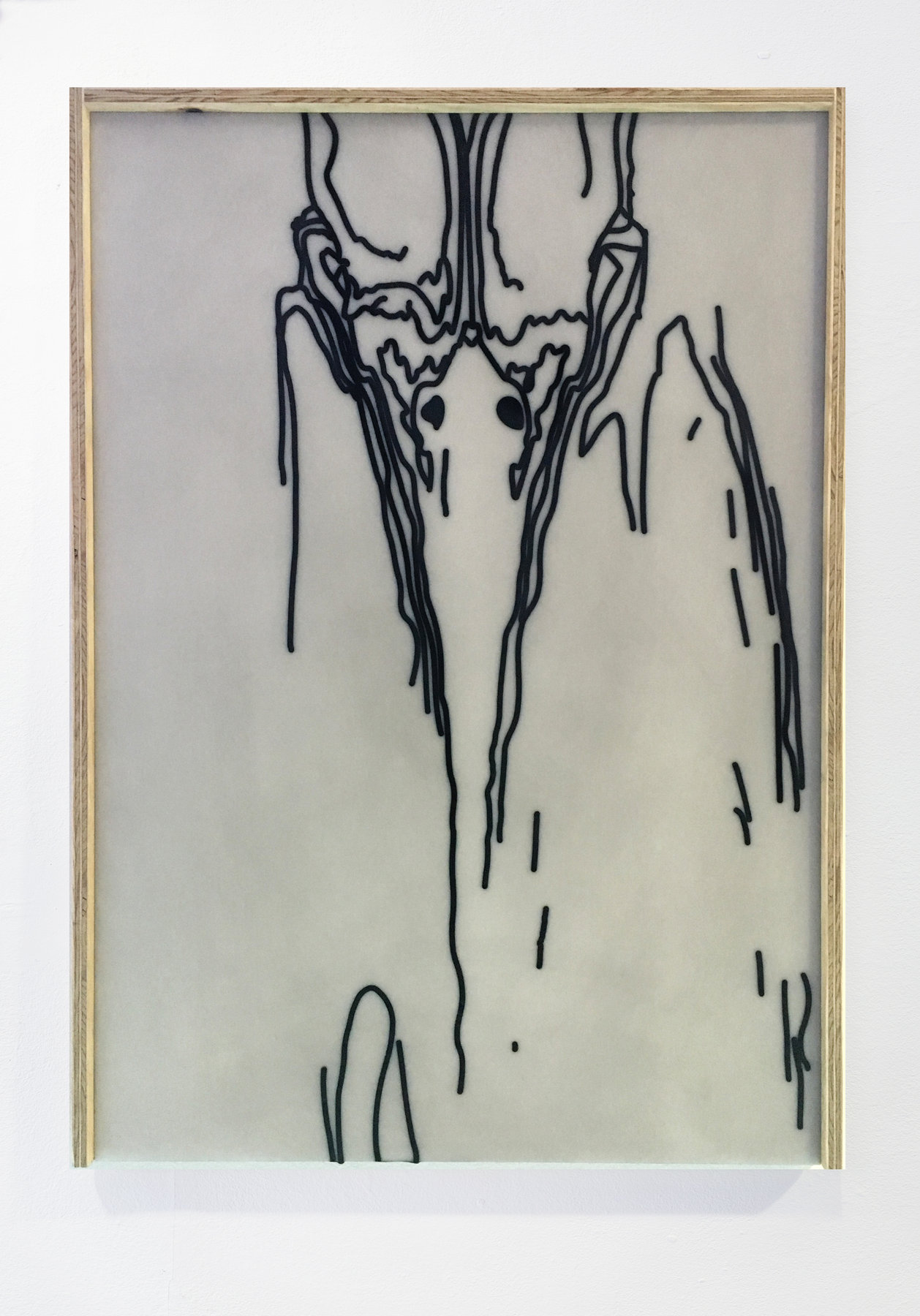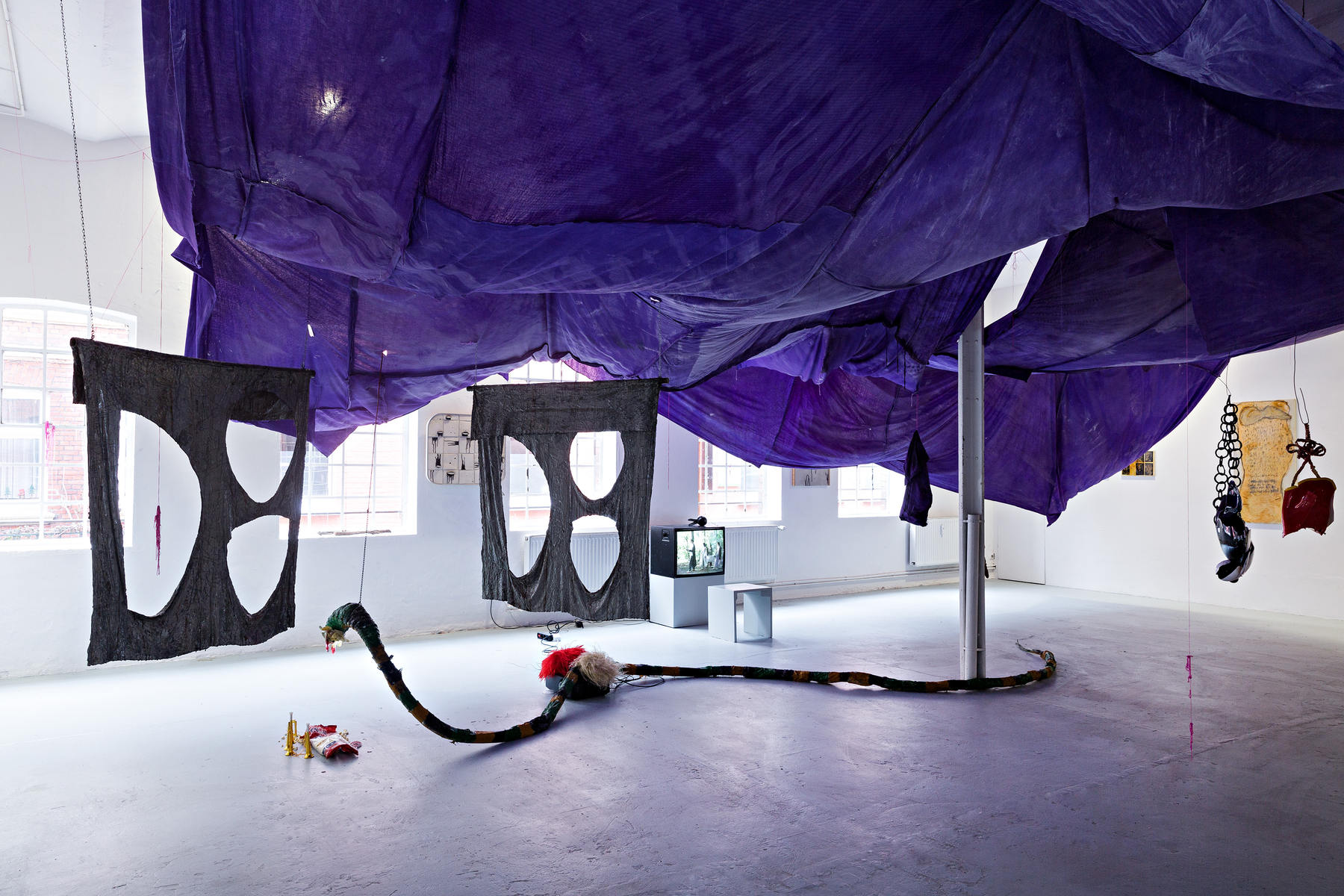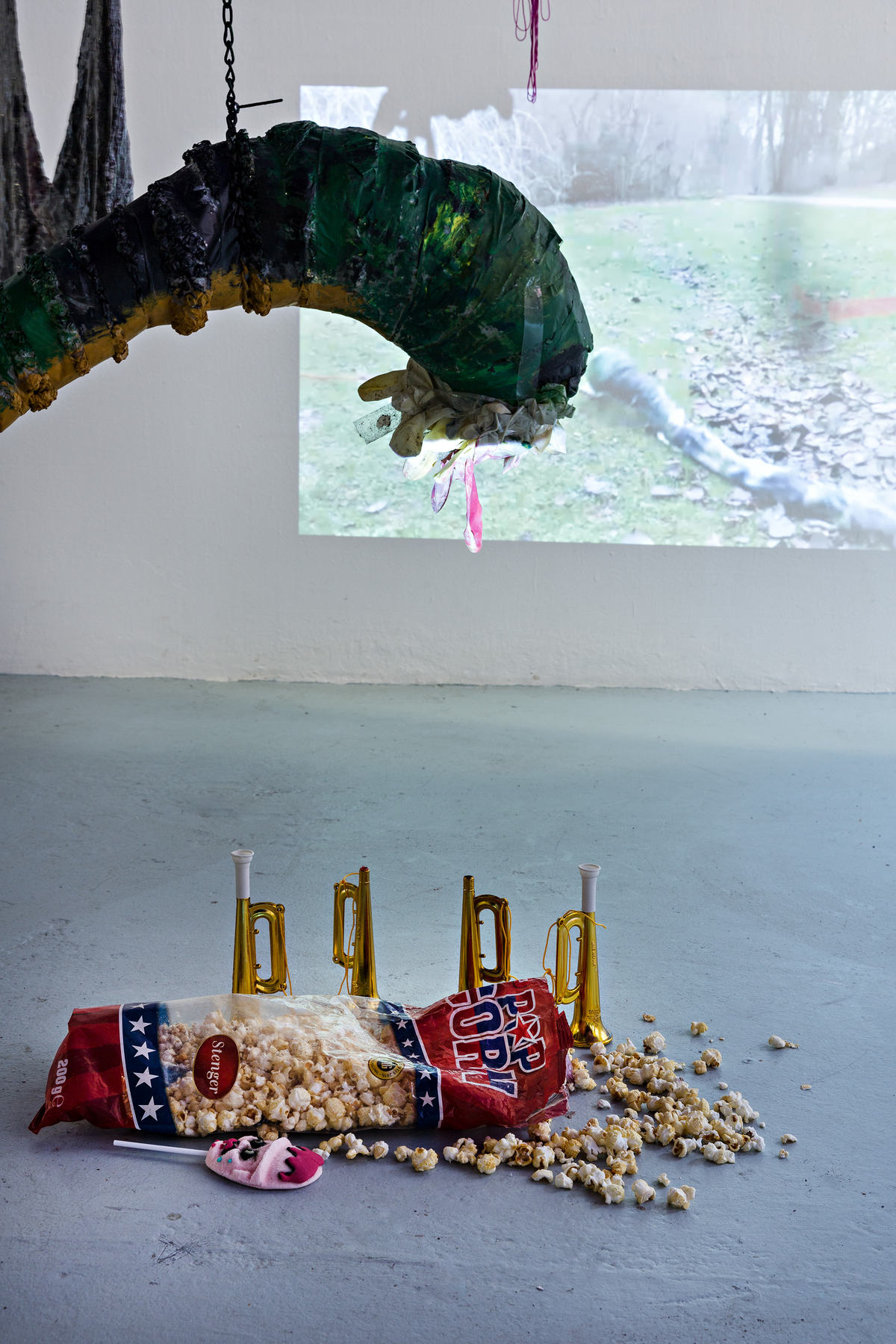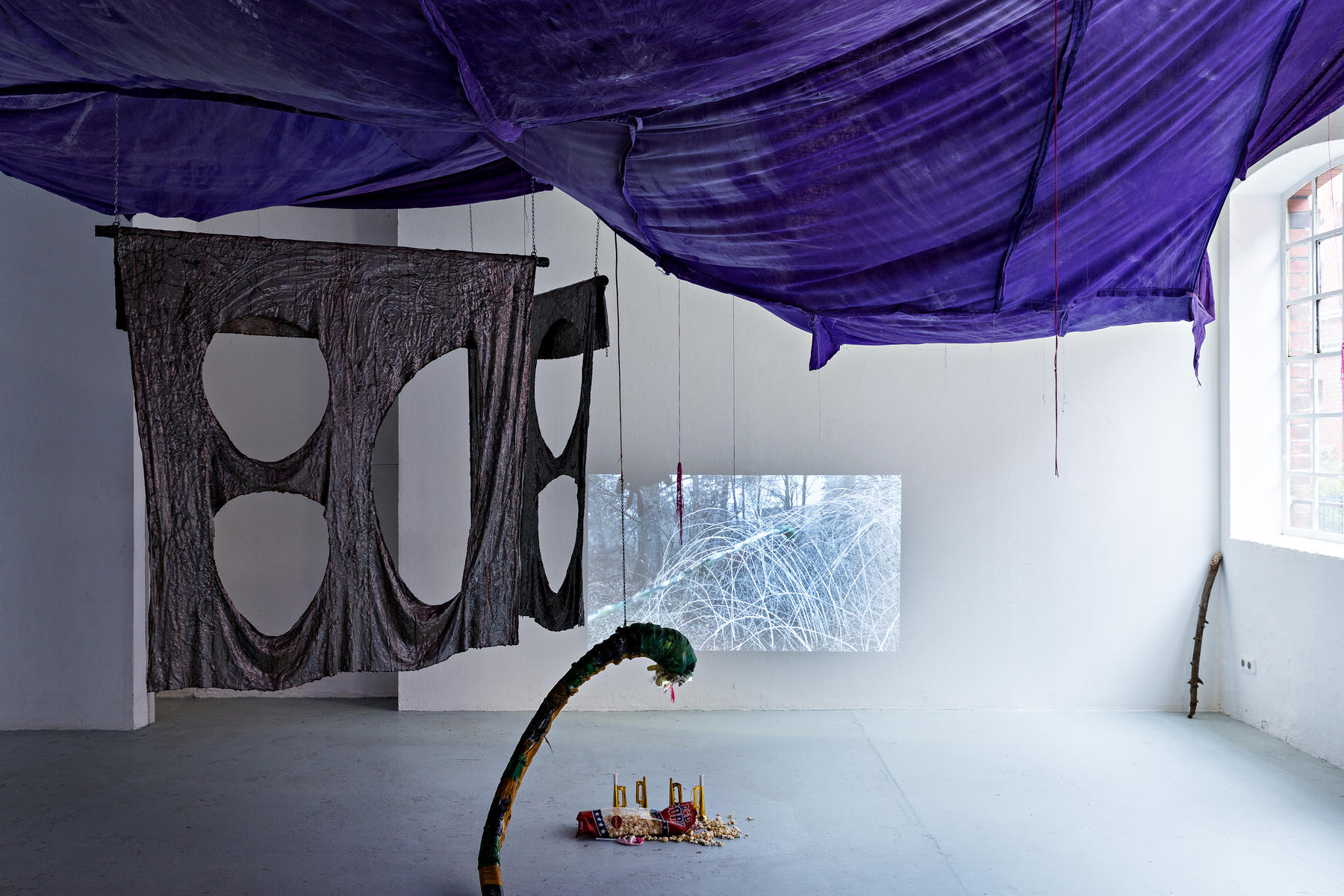Artists: Liz Craft, Michaela Eichwald, Fanal, Birke Gorm, Julia Haller, Honey Suckle Company, Helena Huneke, Stefan Kern, Kontakt Sappho, Veit Laurent Kurz, Ben Schumacher, Stefan Tcherepnin, pcnc_bay, Steit
Exhibition title: GEBÄRDEN UND AUSDRUCK
Venue: Halle für Kunst Lüneburg, Lüneburg, Germany
Date: December 18, 2016 – February 19, 2017
Photography: Fred Dott, all images copyright and courtesy of the artists and Halle für Kunst, Lüneburg
The exhibition “Gebaerden und Ausdruck” is a second part of a three-part series which begun in spring 2016 and will be continued in 2017. It pursues an interest that was already the starting point of considerations of two shows at Halle fuer Kunst: On the one hand, the interest in the moment of ambiguity and ambivalence in contemporary art (“On Radical Juxtaposition”, 2014), on the other, the interest in Kenneth Anger’s notion of film and therefore of cultural and artistic production as a magic ritual, which appears contrary to what today manifests itself as a both deeply ambivalent and questionable art field permeated by economic and power interests (“Magic Lantern Cycle”, 2015).
While the first part of the series was dedicated to the concept of Fantasy, the second turns to the concept of Expression, followed by a third part that will focus on the notion of Authenticity. All three parts are grasped as interrelated aspects of thinking about artistic practice and are based on the attempt to formulate concepts for those moments that interest one in works of art, meaning to positively designate aspects that are met by interest and response, and not only to use a negation to formulate the fact that that quite a bit of contemporary art exhausts itself to a high degree in running through references, in evoking a critical impetus, in a vocabulary schooled in discourse, or in glossy superficiality. Surprisingly, this attempt has brought notions to the fore that are mainly regarded as obsolete and reactionary (fantasy, expression, authenticity). Which is in turn interesting, too, because it seems to reveal a desire to utilize these concepts for contemporary art as well, since they can apparently name something that has to do with the essence and added value of art, meaning something able to generate not only knowledge and experiences, but also intensities. The exhibition series therefore seeks to approach these notions with the awareness of how they are charged and how questionable they are, beyond a clichéd understanding, in order to find out how far and in which direction they can take us. However, the situation has become more complicated in recent years. Against the background of an increasingly stronger criticism of emptied critical or politicized art practices, evoking these moments may not be generally suspected of contributing to a hopelessly antiquated concept of art anymore; but in the wake of the critique of the “political as style” (James Meyer), one must now be careful not to allow a “new inwardness,” an “intensity as style,” to creep in, based on the reactivation of a notion of the autonomy of art restricted to the formal.
While fantasy forms the basis of all cognition – according to Aristotle, the soul does not think without images – and can remain purely imaginary, it belongs to the essence of expression to manifest itself to the senses. As opposed to the sign that refers to something else and signifies according to defined conventions, expression, or to express something or express oneself, cannot be reduced to a simple signifying relation or model of representation. Instead, expression reveals a latent and not explicit meaning that is produced not via the detour of a meaningful context, but directly, and that tends to be indeterminate, incomplete, and infinite. The exhibition is primarily interested in this moment of immediacy and unsaturation, the approach to which, quite in the sense of understanding expression, is not a matter of decoding. While fantasy forms the basis of all artistic practice in that imaginary images are transferred to real ones through the power of imagination, this generality cannot be applied to expression, as it seems, since a large portion of contemporary art can be regarded as a pure transformation achievement, as a pure sign that appears to merge with a simple model of reference. Therefore, the exhibition explicitly aims at artworks that are not preconditioned by representation. Yet even if moments of immediacy and incompleteness are at the fore, it is not about artistic practices that exhaust themselves in purely acting out immediacy. Although the focus is on immediacy, it should not be excluded that there are layers in the addressed works that imply something specific or refer to something concrete. So if expression means becoming experienceable without being based on a relation of reference, the question arises as to what expression actually is, or what or who actually expresses, when something is expressed. A self is commonly associated with expression in a very essentialist way, but something can also express itself through something else (e.g., a medium). In this case, that through which something is expressed serves as an instrument and thus marks the reverse side of what Benjamin termed the “magic of language”, with “language” being understood as all kinds of utterances, thus detaching them from their connection to words. Hence, expressing “something through something” must be distinguished from expressing “something in something”. While the former implies an instrumental use, through which information and contents are communicated, the latter refers to the level of enunciating through which a meaning independent of sense is produced. Even if it mustn’t correspond with the content of what is said, or can even go beyond it, it is inherent to language all the same and directly conveyed in it. This notion of the magic of language, which can also be called the “magic of expression”, appears interesting in the context of the exhibition precisely for the reason that with it the attempt is made to conceive the efficacy of expression with respect to something other than that which is represented manifesting itself in what is expressed. But expression can also be staged (e.g., in theater). This form of expression differs from what was just described in that the emotions shown by the actors, for example, are not necessarily their own, but are merely staged and therefore owe to a translation following certain rules. A similar exemplification not identical with itself can also apply to artworks. For example, they can express sadness, without being sad themselves (or even being able to be sad), just like the artists don’t necessarily have to feel sad to create the works. This means that for an object to express a quality, it needn’t necessarily possess it. It can possess it only metaphorically, not literally. Hence, expression can also be an effect. But this does not mean that it is therefore “untrue”. In view of the conditionality and constructedness of subjects, the question arises of whether all expressions are subject to constituting conditions, meaning that there can be no “true” (but also no “untrue”) expression. This in turn implies that any notion of substance or essence misses the point. Expression, then, is not tied to a substance, even though it is relational and can be traced back to something. So if talk is of the self (e.g., the self of the artist or the self of the work), it does not refer to an authentic, unbroken, unconstructed self that is one with itself. To do justice to this ambivalence, but also to not have to dispense with expression as something that goes beyond the intended meaning and that can be indeterminate, both expression and construction must be conceived together. This attempt reveals a closeness to the rites of possession, for according to Michel Leiris, they also reveal an ambivalent state in which the behavior of the possessed person is characterized by both real participation and forms of expression schooled according to conventions (e.g., the way the possessed person must embody the spirit which possesses him). Although possession ultimately turns out to be a controlled endeavor, the regulation and formalization of being possessed does not mean that it is artificially fabricated in all instances. For the interesting and decisive aspect lies precisely in the possessed persons playing a role, but with the belief that they are under the influence of a real power. Being something and performing something is not a contradiction here. Instead, deception and expression are one, so that being possessed must be grasped as a lived and precisely not as a played theater. For if it were pure theater, it would be without consequences. It is, however, supported by a moment of magic in which the effect transcends the register of the action causing it. In this context, it appears interesting that Expressionism – the name obliging it to expression – is also characterized by a merging of construction and expression and thus by the dissolution of their apparent opposition. Expressive art can be extremely constructed, even if it does not adhere to given, canonical rules, but to rules originating it itself and not borrowed from elsewhere. Here, expression is tied to a relative autonomy. A further aspect of Expressionism is that expression reveals itself in the works as a whole, i.e., in certain features that show them to be realized constellations, and not in individual signs that can be connected back to what is to be expressed. Since that which is triggered and not that which is expressed is relevant for Expressionism, it is liberated both from the coercion to narrate and from prefabricated signs. Therefore, its premises could provide answers to questions of whether and how enunciation could take place beyond reference and beyond codifications and attributions. Regardless of all these considerations, expression consists foremost in setting oneself in relation and reveals moments of encounter and communication. For as Benjamin wrote, humans express themselves in “language”, they communicate with the other. Hence, access to the other lies in expression. One can even say that the other comes into existence for us through expression, because expressing oneself cannot be delegated. Humans can be represented, but not expressed by others. And what presumably also lies in this referencing, in this addressing of and orientation toward the other is the kind of intensity that expression can generate beyond communicating information and making assertions.
GEBÄRDEN UND AUSDRUCK, installation view, Halle für Kunst, Lüneburg, 2016
GEBÄRDEN UND AUSDRUCK, installation view, Halle für Kunst, Lüneburg, 2016
GEBÄRDEN UND AUSDRUCK, installation view, Halle für Kunst, Lüneburg, 2016
Liz Craft, What is she thinking?, 2015, Ceramic, aluminium, 75,5 x 76 cm
Birke Gorm, IOU, 2016, Carved wood, Dimension variable
Birke Gorm, IOU, 2016, Carved wood, Dimension variable
Michalea Eichwald, Literaturkalender I & II, 2008, Collage, acrylic and varnish on canvas, 40 x 30 cm
Honeysuckle Company, Eswerde, 2003, Video (color, audio, 9:10 min, loop)
Honeysuckle Company, Eswerde, 2003, Video (color, audio, 9:10 min, loop)
Michaela Eichwald, Auktion, 2014, Oil, pleather, 220 x 125 cm
Michaela Eichwald, Untitled (Truppen abziehen), 2014, Oil, pencil, pleather, 130 x 50 cm
GEBÄRDEN UND AUSDRUCK, installation view, Halle für Kunst, Lüneburg, 2016
Stefan Kern, Baobao, 2014, High-gloss varnish on aluminium, 96 x 68 x 46 cm
Stefan Kern, Baobao, 2014, High-gloss varnish on aluminium, 96 x 68 x 46 cm
Stefan Kern, MM, High-gloss varnish on aluminium, 125 x 58 x 17 cm
Birke Gorm, IOU, 2016, Carved wood, Dimension variable
Helena Huneke, Untitled, year unknown, 200 x 180 cm
Liz Craft, Word Bubble (Mirror II), 2016, Ceramic, aluminium, 66 x 48 x 6 cm
Julia Haller, Untitled, 2016, Pigment on mineral composite board, 77,5 x 52 cm
GEBÄRDEN UND AUSDRUCK, installation view, Halle für Kunst, Lüneburg, 2016
GEBÄRDEN UND AUSDRUCK, installation view, Halle für Kunst, Lüneburg, 2016
GEBÄRDEN UND AUSDRUCK, installation view, Halle für Kunst, Lüneburg, 2016
GEBÄRDEN UND AUSDRUCK, installation view, Halle für Kunst, Lüneburg, 2016
GEBÄRDEN UND AUSDRUCK, installation view, Halle für Kunst, Lüneburg, 2016
GEBÄRDEN UND AUSDRUCK, installation view, Halle für Kunst, Lüneburg, 2016
GEBÄRDEN UND AUSDRUCK, installation view, Halle für Kunst, Lüneburg, 2016
GEBÄRDEN UND AUSDRUCK, installation view, Halle für Kunst, Lüneburg, 2016
Veit Laurent Kurz, Ben Schumacher, Stefan Tcherepnin, Petra Im Park, 2016, Video (color, audio, 4:00 min, loop)
GEBÄRDEN UND AUSDRUCK, installation view, Halle für Kunst, Lüneburg, 2016
GEBÄRDEN UND AUSDRUCK, installation view, Halle für Kunst, Lüneburg, 2016


































